 At the end of the afternoon we arrive at Robert’s Camp, a beautiful campsite on Lake Baringo. During the trip Peter and I made in 2007 to Kenya and Tanzania (then not as a couple yet), we also visited Robert’s Camp. We both had some good memories of the place: hippos at the campsite, crocodile eyes in the water that light up in your flash light, a boat ride on the lake and a nature walk led by Cliff. We wanted to go back again, but now as “lovers”.
At the end of the afternoon we arrive at Robert’s Camp, a beautiful campsite on Lake Baringo. During the trip Peter and I made in 2007 to Kenya and Tanzania (then not as a couple yet), we also visited Robert’s Camp. We both had some good memories of the place: hippos at the campsite, crocodile eyes in the water that light up in your flash light, a boat ride on the lake and a nature walk led by Cliff. We wanted to go back again, but now as “lovers”.
We recognize the sign that points us to the entrance of the camp and as we stand at the reception desk we recognize the restaurant “The Thirsty Goat”. But that is the only thing that is still the same, because the whole campsite as we remember it is flooded! The water level of Lake Baringo increased rapidly in 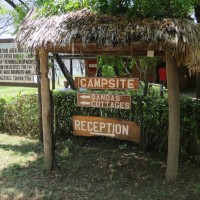 the beginning of 2013 with no less than five meters. A huge amount of water when you consider that the lake is 22km long and 11km wide. The former camping field, the toilet blocks and various cottages have disappeared under the water. In some places parts of walls or roofs stick out above the water, it is a sad sight. But despite the setback, Robert’s Camp is still open. The restaurant is redone, there is a new toilet block and the former parking lot of the adjacent Lake Baringo Club (which had to close) is transformed into a beautiful campground. So we can set up our tent, no problem.
the beginning of 2013 with no less than five meters. A huge amount of water when you consider that the lake is 22km long and 11km wide. The former camping field, the toilet blocks and various cottages have disappeared under the water. In some places parts of walls or roofs stick out above the water, it is a sad sight. But despite the setback, Robert’s Camp is still open. The restaurant is redone, there is a new toilet block and the former parking lot of the adjacent Lake Baringo Club (which had to close) is transformed into a beautiful campground. So we can set up our tent, no problem.
After the hardships in Ethiopia and during the ride along Lake Turkana, it feels like we have arrived at a luxury resort. There is a thick jet of water coming from the shower, there is toilet paper at the clean toilet, the refrigerator of “The Thirsty Goat” is filled with at least three different types of cold beer and they even have a menu full of delicious dishes! With a smile on our faces we join Pim for a cold Tusker and a ‘Spitting Cobra’ pizza. We will definitely stay here for a while!
Apart from the increased water level, it is much the same as seven years ago. It is still a beautiful campsite! Not is the last place because of 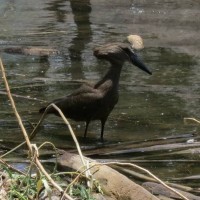 the birds! Around Lake Baringo you can find as many as 400 different birds, 173 of which have been seen at Robert’s Camp. A paradise for ornithologists and also for Peter! With binoculars in his hands, he stares at all the beautiful birds. And it is addictive, because soon after Pim and I are also watching next to Peter. From our armchair we see kingfishers repeatedly take a dip in the water to get a fish. In the bushes small sunbirds buzz from flower to flower, while the sun lets their colours shine. In the waterfront a Hamerkop is looking for fish, while the Striated Heron next to him is trying to swallow the catch of the day. During our breakfast brutal Hornbills try to eat the bread from our plates, while we hear African Fish eagles call each other. If you were not a birdwatcher yet, you will become here for sure!
the birds! Around Lake Baringo you can find as many as 400 different birds, 173 of which have been seen at Robert’s Camp. A paradise for ornithologists and also for Peter! With binoculars in his hands, he stares at all the beautiful birds. And it is addictive, because soon after Pim and I are also watching next to Peter. From our armchair we see kingfishers repeatedly take a dip in the water to get a fish. In the bushes small sunbirds buzz from flower to flower, while the sun lets their colours shine. In the waterfront a Hamerkop is looking for fish, while the Striated Heron next to him is trying to swallow the catch of the day. During our breakfast brutal Hornbills try to eat the bread from our plates, while we hear African Fish eagles call each other. If you were not a birdwatcher yet, you will become here for sure!
Between all the chirping of the birds we hear the occasional loud and heavy “MWOEHAHAHAHA”. Hippos! In the water in front of the restaurant there is a group of hippos. They only show their backs and big head and flap their ears. Occasionally they disappear completely under water to come out snorting a few minutes later. During the day they stay in the water, but when the sun is down and it starts to get dark, they leave the water to graze during the night. And they do so on the campsite, next to our tent! After some splashing, steps in the mud and rustling bushes, we hear them eating grass just beside us. It 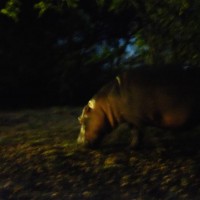 sounds just like a cow. From the tent we see them getting closer, they would almost trip over the ropes of our tent! We sit up to watch the hippos, sometimes four at a time, scurrying around our tent. Every night, fantastic!
sounds just like a cow. From the tent we see them getting closer, they would almost trip over the ropes of our tent! We sit up to watch the hippos, sometimes four at a time, scurrying around our tent. Every night, fantastic!
We just need to be careful when we go to the toilet in the dark, because hippos are very dangerous. They kill more people every year than lions! Despite their heavy body, they can run fast and if you are between the hippo and the water they can run you over on their way to the water. And with their big mouth and sharp teeth they can seriously injure or even kill you. As long as we stay in our tent when they are grazing it is fine. It definitely gives the feeling that we are in Africa! Even though we already had that feeling when we saw a crocodile eat a goat, when the monkeys stole our cookies and when the lady in the kitchen started screaming when she found a snake on her kitchen counter…..
Like seven years ago, we take a boat trip to see the area and the birds. And all under the guidance of … Cliff, the same guide we had in 2007! He is an ornithologist and does not need a book to recognize birds, one chirp is enough for him. As we walk to the boat he points us to one bird after another. He even manages to have an owl answer to his lure after which we can find the little creature high up in the tree.
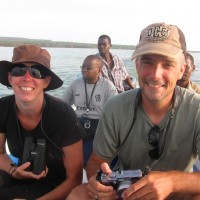 The boat trip is super. It is still early and the light is beautiful. Cliff shows us lots of new birds. We see crocodiles warm up in the morning, while less than 15 meter away the ladies from the village are doing their laundry. From the boat we can see how much damage the rising water has caused and how many buildings have disappeared under the water. Not only hotels and our campsite, but also the local fish factory, a school and several houses. It has only been a year since the flooding, but it has already had a devastating effect on the buildings. The animals have adapted much faster than the inhabitants of the village. The crocodiles lurk in the former hotel rooms, the hippos waddle across the floor of the restaurant and the birds have built a nest in the rafters of the reception.
The boat trip is super. It is still early and the light is beautiful. Cliff shows us lots of new birds. We see crocodiles warm up in the morning, while less than 15 meter away the ladies from the village are doing their laundry. From the boat we can see how much damage the rising water has caused and how many buildings have disappeared under the water. Not only hotels and our campsite, but also the local fish factory, a school and several houses. It has only been a year since the flooding, but it has already had a devastating effect on the buildings. The animals have adapted much faster than the inhabitants of the village. The crocodiles lurk in the former hotel rooms, the hippos waddle across the floor of the restaurant and the birds have built a nest in the rafters of the reception.
Lake Baringo is one of the many lakes in the Great Rift Valley. This valley runs from Syria to Mozambique and is formed by plates of the earth that are slowly drifting apart. In the valley are some very deep lakes of which we have already seen a number (like Lake Abayo, Lake Awassa and Lake Turkana). From the boat we can see that Lake Baringo is also situated in the valley, with cliffs on both sides. That same afternoon, Cliff takes us for a walk to the edge of the valley. We climb the cliff and have a beautiful view over the lake and the steep wall on the other side of the valley. On the way there we see ostriches, scorpions, snakes and again a lot of birds.
We enjoy a little vacation at Robert’s Camp and end up staying more than a week. We eat more “spitting cobra pizzas”, but also enjoy the seafood platter which Big Mama Brenda prepares for us. We trudge through the village to the luxurious Soi Lodge for a swim and to use  their Internet. We go shopping in the village and cooking pasta or rice together with Pim. We pick up some Swahili and talk with the people in the village. We take plenty of time to drink coffee, read a book, work on the bikes or the blog and settle down every night in the cozy chairs at “The Thirsty Goat” for a drink. Great!
their Internet. We go shopping in the village and cooking pasta or rice together with Pim. We pick up some Swahili and talk with the people in the village. We take plenty of time to drink coffee, read a book, work on the bikes or the blog and settle down every night in the cozy chairs at “The Thirsty Goat” for a drink. Great!
And as that happens when you stay in one place for a long time, we again meet some great people. We meet Michaela, Timm and their four children from Germany. During a trip through Africa with their daughter, they got ’stuck’ (by choice) in South Africa. They built a house there, started a business, had three children and lived over five years in Cape Town. When we meet them they were heading back to Germany to live there a few years. They travel in a super tough Landrover with a trailer and quad on top of the trailer. On the roof of the car is a huge roof tent where they sleep all six of them. Wonderful people and certainly a huge inspiration to know that traveling does not have to end when you have children… ( A link to their blog can be found on our list of “Overlanders on the road” )
A few days after the German family left, another Landrover parks at the campsite. Two friends, Belgian Steve and Dutchman Pieter, take a trip through -as they themselves say- the ‘easy countries of Africa’ (see “Overlanders on the road”). From South Africa they have now reached their most northern point in Kenya and will ride south again through Tanzania and Malawi. Trendy guys, that -to my slight surprise- turn out to be fanatical birdwatchers. Armed with a large lens on their photo camera and two thick books about birds, they stare at the trees around them. Only when we look at their bird books, we see just how many yellow-and-black birds there actually are. Even with  the book it is quite difficult to find the right one. But searching for the right bird makes it a fun challenge! We do not have space for a bird book, but we do find a great app for the iPad with all the East African Birds. This makes it even more fun!
the book it is quite difficult to find the right one. But searching for the right bird makes it a fun challenge! We do not have space for a bird book, but we do find a great app for the iPad with all the East African Birds. This makes it even more fun!
Along with Pieter, Steve and Pim we again take a boat trip with Cliff to see birds, but also just to enjoy the amazing views. I would be able to do this every day, I love it! Cliff buys fish from a local fisherman to feed to the African Fish eagle. With a piece of wood in the fish, the fish floats in the water. Cliff calls the eagle, that comes flying from a great distance and grabs the fish out of the water with his big claws. On the boat the cameras are clicking. Steve makes beautiful pictures with his large camera lens.
After 10 days, we pack our stuff again. Although I could have stayed for another month at Robert’s Camp, it is time to move on and to visit other parts of Kenya. The manager seems to agree: “Are you leaving? Finally!”, he says with a smile on his face.
Together with Pim we drive further south passed Lake Nakuru in the direction of Lake Naivasha. Halfway we suddenly see a big yellow sign on the side of the road: “You are now approaching the equator.” The equator! That is quit something. Here we are, riding on our own motorbikes from the northern to the southern hemisphere. Very cool! We stop and park our bikes at the equator to take a pictures of this moment for our future grandchildren.
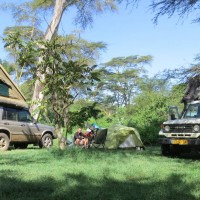 At Lake Naivasha we pitch our tent at Carnelly’s between the roof tent of Pim on one side and the roof tent of Pieter and Steve on the other side. It is a beautiful campsite on the edge of the lake, where again many birds can be found. If we take a stroll around the camp we see a Crested Eagle, pelicans, more African fish eagles, Marabou storks, a Giant Kingfisher and cute little lovebirds. High up in the trees Colobus monkeys are jumping from one branch to another, their long black and white tails swaying behind them. The next day we do not get on the motorbikes, but on two bicycles! We go to Hell’s Gate National Park, one of the few parks in Kenya where you can walk or cycle. Along with Pim, Peter and I make our way up the hills to the entrance of the park. Our condition is not really improved after four months of sitting on the bike, so we are both panting as a post horses when we buy our tickets. And then our bike ride through the park has yet to begin, that is promising.
At Lake Naivasha we pitch our tent at Carnelly’s between the roof tent of Pim on one side and the roof tent of Pieter and Steve on the other side. It is a beautiful campsite on the edge of the lake, where again many birds can be found. If we take a stroll around the camp we see a Crested Eagle, pelicans, more African fish eagles, Marabou storks, a Giant Kingfisher and cute little lovebirds. High up in the trees Colobus monkeys are jumping from one branch to another, their long black and white tails swaying behind them. The next day we do not get on the motorbikes, but on two bicycles! We go to Hell’s Gate National Park, one of the few parks in Kenya where you can walk or cycle. Along with Pim, Peter and I make our way up the hills to the entrance of the park. Our condition is not really improved after four months of sitting on the bike, so we are both panting as a post horses when we buy our tickets. And then our bike ride through the park has yet to begin, that is promising.
But once inside the park, we ride onto a large open area and cycle slowly down. There is some sunshine and a breeze, perfect weather for a ride on these bikes! From the saddle of our bicycles we see all sorts of wildlife: zebras, buffaloes, giraffes, antelopes, warthogs. Really great! And yet a bit exciting because there is a chance that we encounter lions and elephants. We cycle slowly through the park, stopping frequently for photos or just looking at the animals using our binoculars.
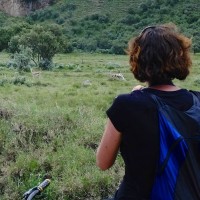 At the beginning of the afternoon we park our bicycles and climb into the gorge at the other side of the park. We follow a local boy who has offered to be our guide. The water has carved out the sides of the gorge beautifully.
At the beginning of the afternoon we park our bicycles and climb into the gorge at the other side of the park. We follow a local boy who has offered to be our guide. The water has carved out the sides of the gorge beautifully.
Across the gorge are warnings of “Flash Floods”, a tidal wave that suddenly runs through the now dry gorge when it rains. At various places emergency exits have been constructed, where you can climb out of the gorge with the help of a rope ladder. In itself, we did not pay much attention to it, until we hear the rumbling in the distance and it suddenly starts to rain very heavy. We follow our ‘guide’ to the first emergency exit and shelter under the roof of a souvenir stall. Once the rains stops, we get back on our bikes to go to the campsite. Halfway it starts to rain really heavy again. Like wet kittens and with a sore bum we arrive at the campsite in the late afternoon. With long trousers, a thick sweater and warm socks we join Pieter, Steve and Pim for dinner and we toast to a very nice day.
Tomorrow we move on, to Nairobi.
Click here to view the pictures.
Distance travelled to Lake Naivasha: 13,798km (8,576 miles)
PS : For those who also love birds hereby a list of all the birds we have spotted until Laka Naivasha: African Darter, Common Squacco Heron, Striated Heron, Great Egret, Goliath Heron, Purple Heron, Intermediate Egret, Hamerkop, Yellow-billed Stork, Marabou Stork, Sacred Ibis, Hadada Ibis, Greater Flamingo, Egyptian Goose, Black Kite, African Fish Eagle, Osprey, Long-crested Eagle, Black Crake, African Jacana, Common Sandpiper, Gull-billed Tern, White-winged Tern, African Mourning Dove, Brown Parrot, Fischer’s Lovebird, White-bellied Go-away-bird, White-browed Coucal, African Scops-Owl, Verreaux’s Eagle-Owl, Pearl-spotted Owlet, Speckled Mousebird, Pied Kingfisher, Giant Kingfisher, Woodland Kingfisher, Malachite Kingfisher, Blue-cheeked Bee-eater, Northern Carmine Bee-eater, Lilac-breasted Roller, Green Wood-hoopoe, Red-billed Hornbill, Jackson’s Hornbill, Hemprich’s Hornbill, Cardinal Woodpecker, Banded Martin, Yellow Wagtail, Common Bulbul, Spotted Morning-Thrush, Lead-coloured Flycatcher, African Paradise-flycatcher, Mouse-coloured Penduline-Tit, Hunter’s Sunbird, Beautiful Sunbird, Brubru, Fork-tailed Drongo, White-headed Buffalo-Weaver, White-billed Buffalo-Weaver, White-browed Sparrow-Weaver, Black-headed Weaver, Northern Masked Weaver, Black-headed Weaver, Golden-backed Weaver, African Black-headed Oriole, Long-tailed Cormorant, Great Cormorant, Greater Flamingo, Pink-backed Pelican, Red-winged Starling, Bristle-crowned Starling, Rüppell’s Long-tailed Starling, Greater Blue-eared Starling, Superb Starling, Parrot-billed Sparrow, Rufous Chatterer, Northern White-crowned Shrike, White-fronted Bee-eater, Augur Buzzard, Verreaux’s Eagle, Lammergeier, Eurasian Hoopoe, Common Ostrich, Trumpeter Hornbill, Vulturine Guineafowl, Red-cheeked Cordon-bleu, African Firefinch en de Tropical Boubou!
Previous story “Turkana Route III – 1,000 km offroad” – Next story “Brown bread with Dutch cheese“





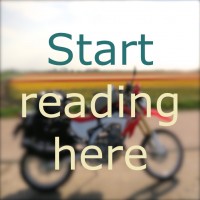


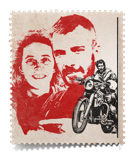
Dit was alweer zo’n prachtig verhaal van jullie. Wat is het toch heerlijk om met jullie mee te kunnen genieten.
Hey Leonie en Peter,
Wat een prachtige foto’s! En wat ontzettend leuk dat we zo jullie avontuur kunnen mee beleven. Ik volg trouw jullie blog 😉 Hoe meer blogs ik lees hoe meer het begint te kriebelen. Ik denk dat ik een wereld/rondreis maar op mijn bucket-list zet!
Veel plezier!
Liefs
Mooie foto’s weer! Ik zit echt mee te genieten als ik het verhaal lees en daarna de foto’s bekijk; heerlijk :-).
Spannend en indrukwekkend he, van die knorrende kolossen rond je tent!
xxx
Lieve Peter en Leonie,
Groet vanuit een ander plekje in hetzelfde grote Afrika. Dank voor de prachtige foto’s en het mooie verhaal dat weer met het hart geschreven is. We kunnen ons nu, met de huidige eigen reiservaring in Marokko, nog beter voorstellen hoe lastig het is om te rijden op moeilijk terrein in een warm klimaat.
Hou je taai! Marijke en Ton
Ha Leonie en Peter,
Met stijgende jaloezie heb ik dit blog zitten lezen, wauw, wauw, wauw, wat een indrukwekkende lijst!
Maar de White-bellied Go-away-bird springt er toch wel uit voor mij, geweldig wat een naam! XXx vanaf nu ieder blog zo’n lijstje?
Lieve Leonie en Peter, 3 blogs achter elkaar gelezen na een weekje vogels spotten in Polen. Dus weer helemaal bij! Wat word je daar enthousiast van he als je een vogel ziet die je daarvoor alleen in een vogelboek had gezien!! Misschien kunnen jullie op de terugweg ff langs Polen gaan, zeer de moeite waard!
Wat leuk om die filmpjes te zien, en wat knap om heelhuids over die gaten te komen. Petje af hoor. Dikke dikke knuffel xxx
Kijk, nou wordt t weer leuk! Lang leve ‘makkelijk Afrika’. Prachtige plaatjes ook weer, ik wist niet eens dat ik van vogels hield
Zo ontzettend beeldend geschreven. Ik ben helemaal mee! Prachtige foto’s. Het lijkt me daar een waar paradijs.
Liefs!
Kopje koffie erbij en maar genieten. Dank!